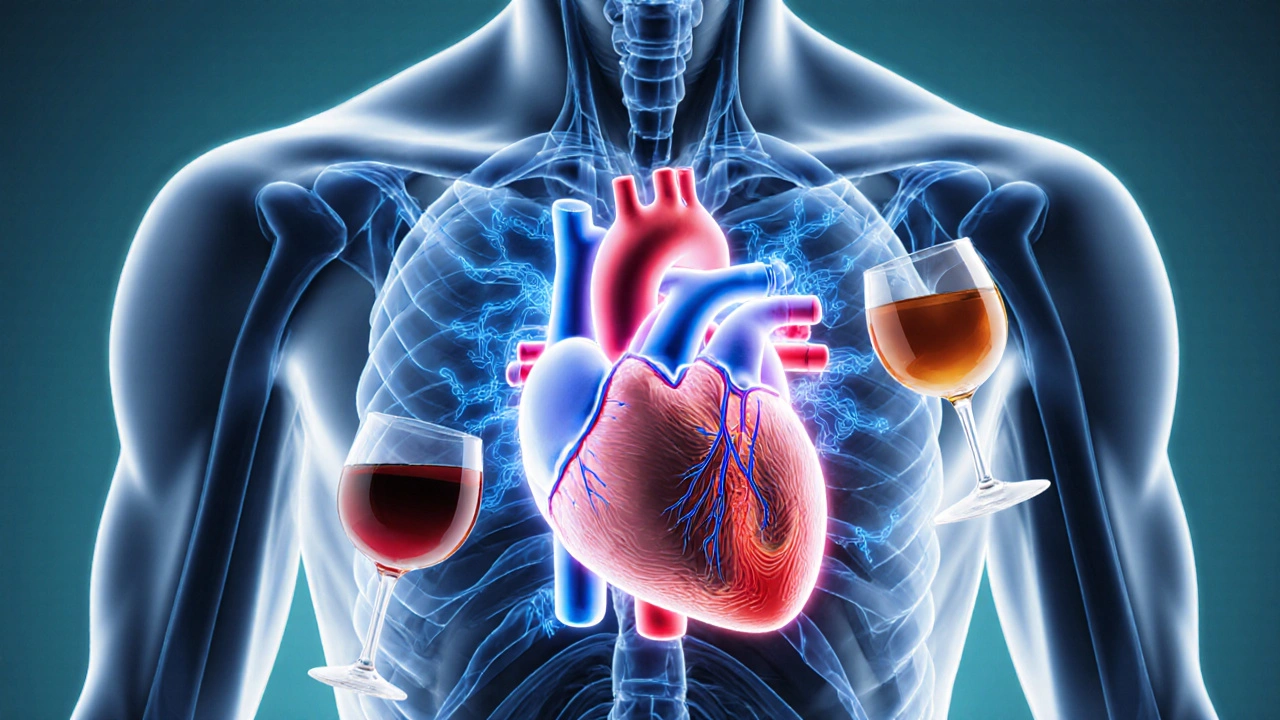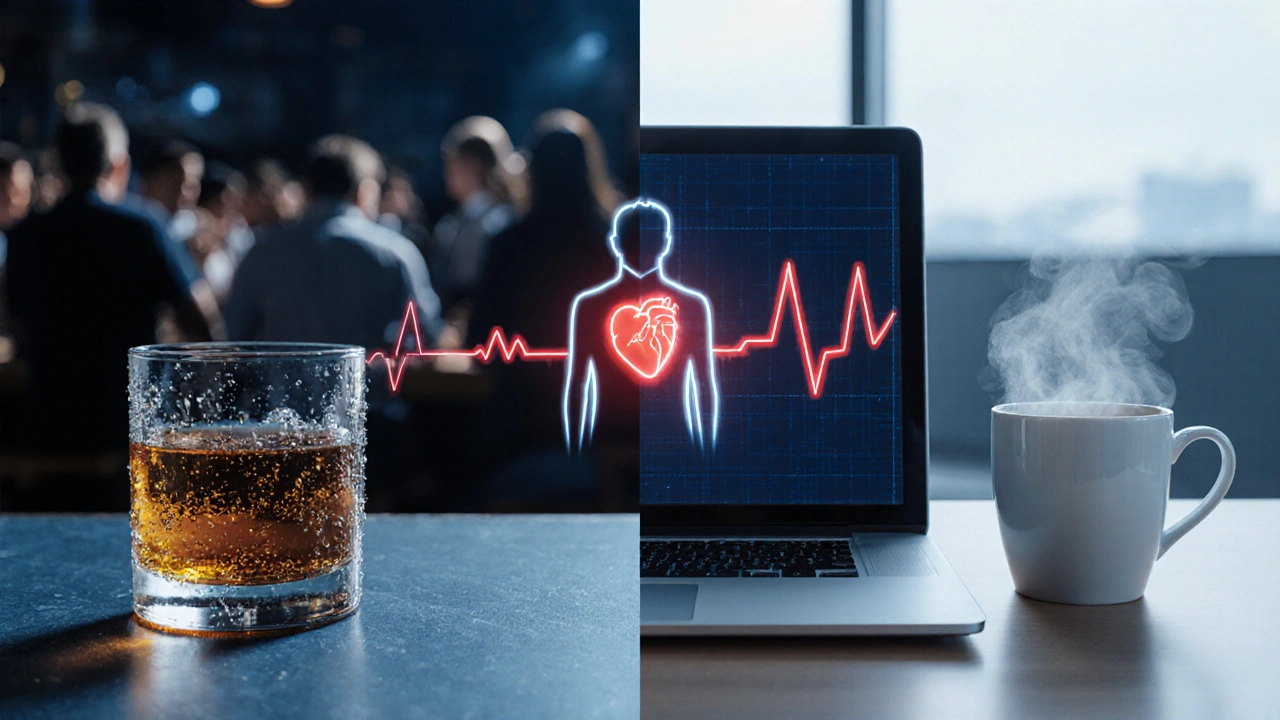
Alcohol & Caffeine Heart Rhythm Impact Calculator
Your Heart Rhythm Analysis
Alcohol Effects
Affects heart rate, can increase arrhythmia risk with binge drinking.
Caffeine Effects
Stimulates heart rate and atrial excitability.
Ever wonder why a night out or that extra espresso can make your heart feel like it’s doing a little dance? The beat of your heart isn’t just a steady thump; it reacts to what you drink. Below we break down how alcohol heart rhythm interactions work, how caffeine joins the party, and what you can do to keep the rhythm smooth.
What is heart rhythm, really?
Heart Rhythm is the pattern of electrical impulses that tell the heart muscles when to contract and relax. A normal rhythm, called sinus rhythm, is regular and predictable-about 60 to 100 beats per minute for adults. When the timing gets off, you get an Arrhythmia, which simply means “irregular heartbeat.” Some arrhythmias are harmless, while others need medical attention.
Alcohol’s punch on the heart’s electrical system
Alcohol is a depressant, but its effect on the heart isn’t as simple as “slowing everything down.” Here’s what research shows:
- Acute intake: A single binge can raise adrenaline, which speeds up the heart and makes the atria (the upper chambers) more irritable.
- Chronic use: Regular heavy drinking over months can lead to structural changes-fibrosis in the heart muscle-that set the stage for persistent arrhythmias.
- Holiday heart syndrome: Even moderate amounts (2‑3 drinks) in a short period can trigger atrial fibrillation in people with no prior heart disease.
In terms of concrete numbers, a 2023 meta‑analysis of 12 studies found that people who drank more than 14 drinks per week had a 1.5× higher risk of developing atrial fibrillation compared to nondrinkers.
Caffeine’s brisk boost to cardiac timing
Caffeine is a stimulant that blocks adenosine receptors, preventing the brain’s natural “slow‑down” signal. This leads to a cascade:
- Higher levels of norepinephrine and epinephrine.
- Increased heart rate (often 5‑15 beats per minute higher for a cup of coffee).
- Greater atrial excitability, especially in people who already have borderline electrical stability.
Most healthy adults tolerate up to 400mg of caffeine a day (about four cups of coffee) without serious rhythm issues. However, a 2022 Australian cohort study showed that individuals consuming more than 600mg daily had a 20% higher incidence of premature ventricular contractions (PVCs) on Holter monitoring.
When alcohol and caffeine team up
Mixing the two can be a double‑edged sword. Alcohol raises adrenaline and can thin the blood, while caffeine spikes the heart rate. Together they amplify the electrical turbulence:
| Effect | Alcohol | Caffeine | Combined |
|---|---|---|---|
| Heart rate change | +5‑15 bpm (acute) | +5‑15 bpm (moderate dose) | +10‑30 bpm |
| Arrhythmia trigger | AFib, PVCs (binge) | PVCs, supraventricular tachycardia | Higher likelihood of AFib episodes |
| Blood pressure impact | Transient drop, then rebound | Short‑term rise | Fluctuating spikes |
The combo doesn’t just add up; it can create a chaotic environment for the Autonomic Nervous System (ANS), which controls heart rate variability. When the ANS is overstimulated, it can cause the heart’s electrical pathways to fire out of sync.

Key arrhythmias to watch for
Not every extra beat is dangerous, but some patterns signal you should call a doctor:
- Atrial Fibrillation (AFib): Rapid, irregular beating of the atria. Symptoms include palpitations, shortness of breath, and fatigue.
- Ventricular Tachycardia (VT): Fast rhythm originating in the ventricles; can be life‑threatening if sustained.
- Premature atrial or ventricular contractions (PACs/PVCs): Usually benign, but frequent episodes (>10% of beats) merit evaluation.
For most people, occasional PACs after a coffee or a glass of wine are harmless. The red flag is when they become regular, cause dizziness, or occur at rest.
How to protect your rhythm while still enjoying a drink
Here are practical steps you can incorporate right away:
- Know your limits: Keep alcohol to ≤1standard drink per day for women and ≤2 for men. A standard drink in Australia is about 10g of pure alcohol.
- Time caffeine wisely: Avoid caffeine within 4‑6hours of bedtime to prevent sleep‑related heart rate spikes.
- Stay hydrated: Alcohol is a diuretic; dehydration can lower electrolyte levels, worsening arrhythmia risk.
- Monitor electrolytes: Magnesium and potassium help stabilize cardiac cells. Foods like bananas, leafy greens, and nuts are good sources.
- Track your heart: Use a wearable or a simple pulse check after drinking. If you notice a resting heart rate above 100bpm or irregular beats, pause the intake.
- Seek medical advice if you have any of the following: family history of AFib, existing hypertension, or a previous arrhythmia diagnosis.
For those already diagnosed with an arrhythmia, doctors often recommend limiting alcohol to occasional, low‑quantity occasions and keeping caffeine under 200mg per day.
When to see a professional
Even if you feel fine, certain scenarios demand a check‑up:
- Palpitations lasting more than a few minutes.
- Dizziness, fainting, or chest pain after drinking.
- New onset of rapid heartbeat (over 120bpm) at rest.
- Any irregular rhythm you catch on a smartwatch or fitness band.
Doctors may order an ECG, Holter monitor (24‑48hour recording), or an event recorder to capture episodes. Treatment can range from lifestyle tweaks to medication or, in some cases, catheter ablation.
Bottom line: enjoy responsibly, listen to your body
Alcohol and caffeine each have distinct ways of nudging your heart’s electrical system. Used in moderation, they’re unlikely to cause lasting trouble for a healthy heart. The trouble starts when the dose climbs, the habit becomes daily, or you have underlying risk factors. By staying aware of your intake, keeping an eye on symptoms, and consulting a healthcare professional when needed, you can savor a latte or a glass of wine without turning your heart rhythm into a roller‑coaster.
Frequently Asked Questions
Can a single night of heavy drinking cause permanent heart rhythm problems?
Usually not. A bout of “holiday heart syndrome” often resolves within a few days once alcohol clears from the system. Persistent issues are more linked to repeated binge drinking.
Is it safe to have coffee before a workout if I have occasional PVCs?
For most people, a moderate coffee (up to 200mg caffeine) before exercise is fine. If PVCs become frequent during the workout, cut back on caffeine and talk to a doctor.
How much alcohol is considered “moderate” for heart health?
Guidelines vary by country, but a common benchmark is up to one standard drink per day for women and up to two for men. Anything beyond that raises arrhythmia risk.
Do energy drinks affect heart rhythm the same way as coffee?
Energy drinks often combine caffeine with other stimulants (taurine, guarana) and high sugar, which can amplify heart rate spikes. They’re generally riskier than plain coffee for people prone to arrhythmias.
Can staying hydrated offset the heart‑rate effects of alcohol?
Hydration helps maintain electrolyte balance, which can reduce the likelihood of premature contractions. It won’t completely nullify alcohol’s impact on the autonomic nervous system, but it does help.
10 Comments
Write a comment
More Articles

How Progesterone Alleviates Adrenal Fatigue and Stress
Progesterone plays a key role in managing adrenal fatigue and stress. This hormone can help balance the body's stress response, improve mood, and enhance overall well-being. Understanding how progesterone functions and ways to incorporate it can be life-changing for those dealing with chronic stress.

Bladder Retraining: Natural Solution for Overactive Bladder Relief
Bladder retraining can be a real game-changer for people struggling with overactive bladder symptoms. This article uncovers the practical steps, science, and psychological boost behind retraining, showing how it helps cut down those urgent trips to the loo. Anyone dealing with leaks, nighttime interruptions, or sudden urges will find clear tips and facts that can be put to work right away. Discover why many doctors suggest it before jumping to medications or invasive options. By the end, readers get the tools and confidence to manage their bladder proactively and regain daily freedom.


Irene Harty
October 4, 2025 AT 13:16One must consider the hidden motives behind such seemingly benign health advice; the article conveniently skirts any mention of pharmaceutical interests that benefit from promoting the notion that moderate consumption is harmless. The underlying narrative appears designed to keep consumers complacent while the industry quietly profits from the inevitable increase in chronic cardiac monitoring devices. Moreover, the selective citation of studies raises eyebrows, suggesting a curated bibliography that supports the desired conclusion while omitting contrary evidence. In an era where data manipulation is rampant, readers should remain vigilant and demand transparency regarding funding sources and potential conflicts of interest.